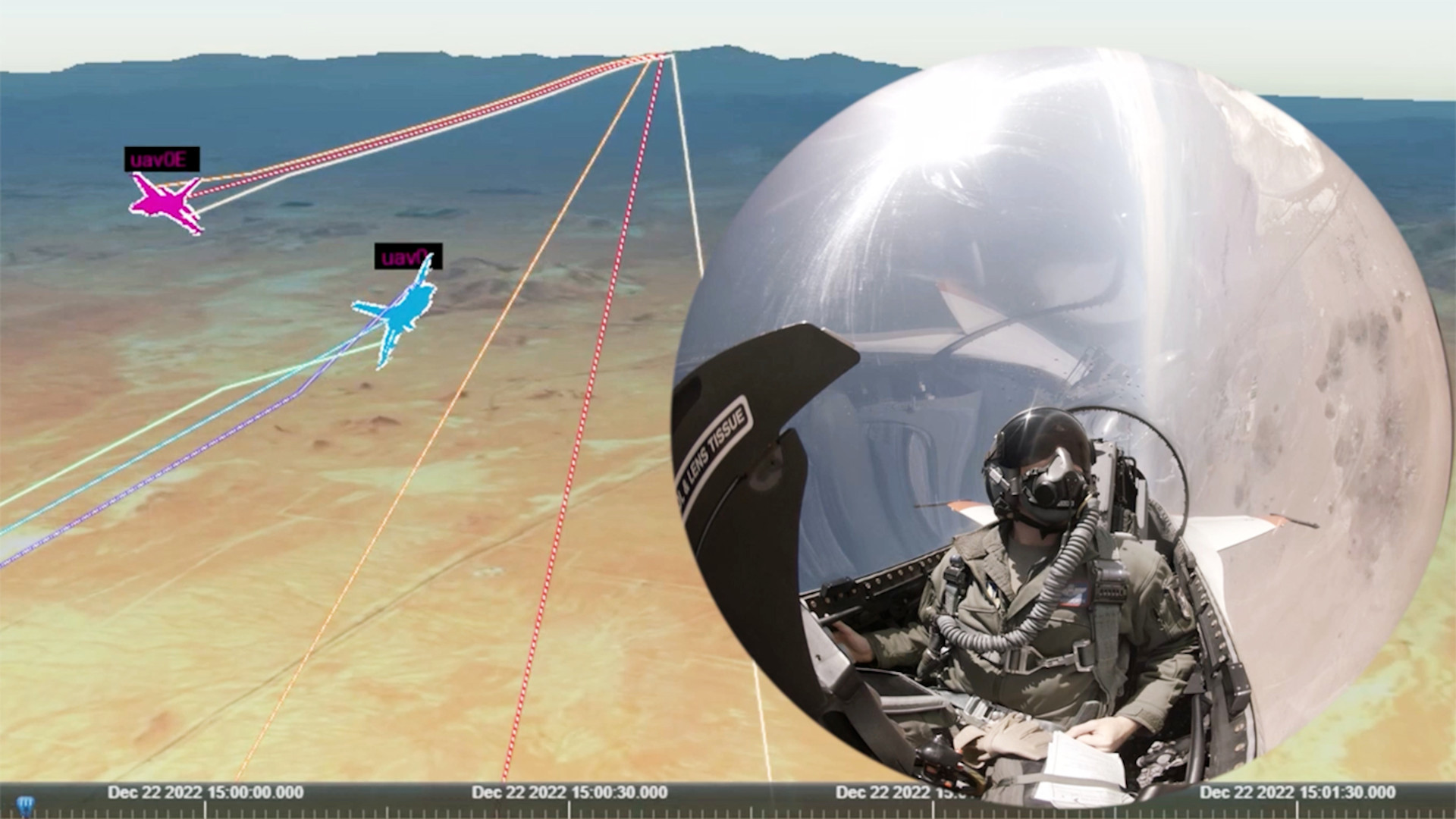Last year, the uniquely modified F-16 test jet known as the X-62A, flying in a fully autonomous mode, took part in a first-of-its-kind dogfight against a crewed F-16, the U.S. military has announced. This breakthrough test flight, during which a pilot was in the X-62A’s cockpit as a failsafe, was the culmination of a series of milestones that led 2023 to be the year that “made machine learning a reality in the air,” according to one official. These developments are a potentially game-changing means to an end that will feed directly into future advanced uncrewed aircraft programs like the U.S. Air Force’s Collaborative Combat Aircraft effort.
Details about the autonomous air-to-air test flight were included in a new video about the Defense Advanced Research Projects Agency’s (DARPA) Air Combat Evolution (ACE) program and its achievements in 2023. The U.S. Air Force, through the Air Force Test Pilot School (USAF TPS) and the Air Force Research Laboratory (AFRL), is a key participant in the ACE effort. A wide array of industry and academic partners are also involved in ACE. This includes Shield AI, which acquired Heron Systems in 2021. Heron developed the artificial intelligence (AI) ‘pilot’ that won DARPA’s AlphaDogfight Trials the preceding year, which were conducted in an entirely digital environment, and subsequently fed directly into ACE.
“2023 was the year ACE made machine learning a reality in the air,” Air Force Lt. Col. Ryan Hefron, the ACE program manager, says in the newly released video, seen in full below.

DARPA, together with the Air Force and Lockheed Martin, had first begun integrating the so-called artificial intelligence or machine learning “agents” into the X-62A’s systems back in 2022 and conducted the first autonomous test flights of the jet using those algorithms in December of that year. That milestone was publicly announced in February 2023.
The X-62A, which is a heavily modified two-seat F-16D, is also known as the Variable-stability In-flight Simulator Test Aircraft (VISTA). Its flight systems can be configured to mimic those of virtually any other aircraft, which makes it a unique surrogate for a wide variety of testing purposes that require a real-world platform. This also makes VISTA an ideal platform for supporting work like ACE.
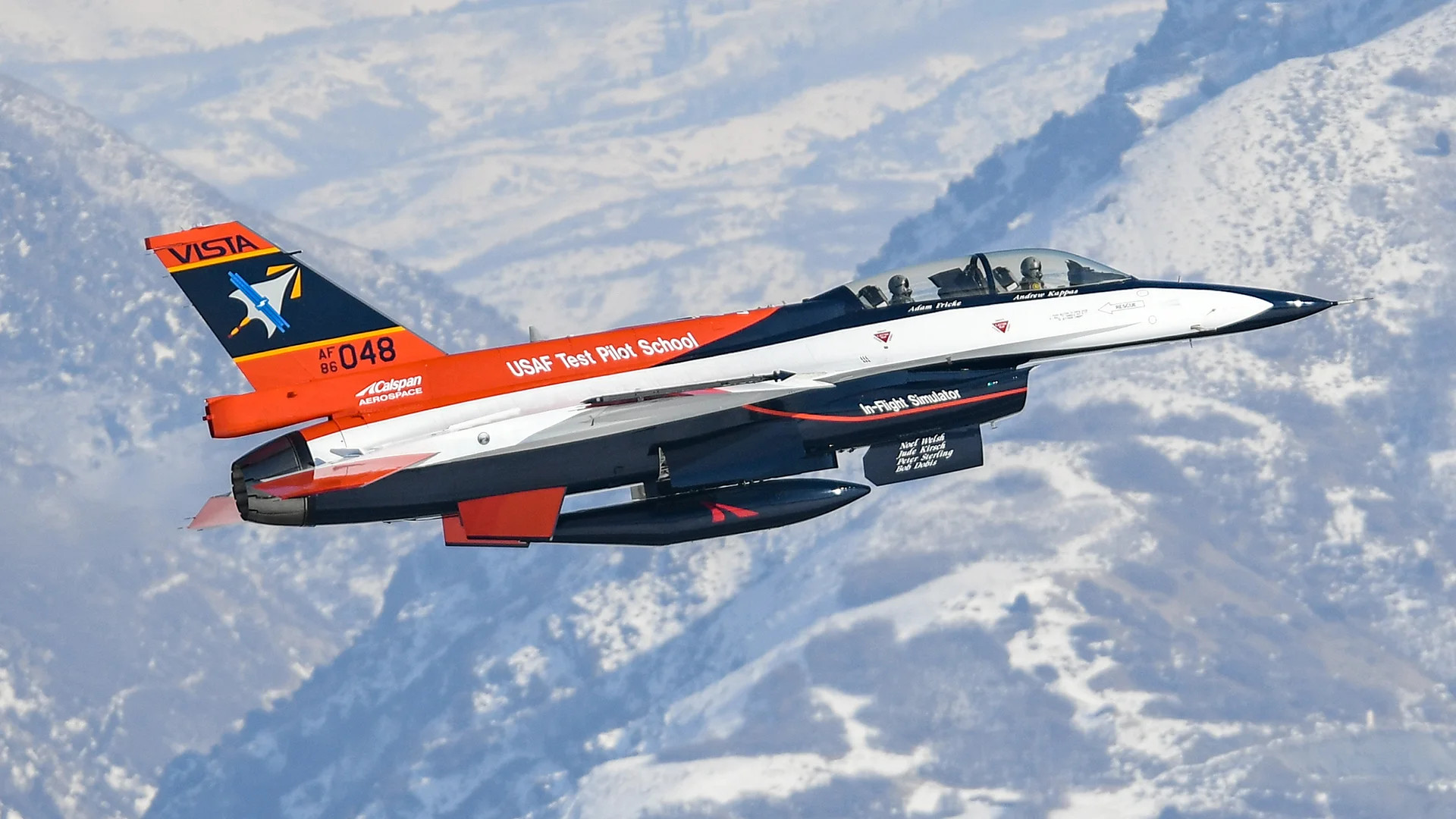
“So we have an integrated space within VISTA in the flight controls that allows for artificial intelligence agents to send commands into VISTA as if they were sending commands into the simulated model of VISTA,” Que Harris, the lead flight controls engineer for the X-62A at Lockheed Martin, says in the new ACE video. Harris also described this as a “sandbox for autonomy” within the jet.
The X-62A’s original designation was NF-16D, but it received its new X-plane nomenclature in 2021 ahead of being modified specifically to help support future advanced autonomy test work. Calspan, which is on contract with the USAF TPS to support the X-62A’s operations, was a finalist for the 2023 Collier Trophy for its work with the test jet, but did not ultimately win. Awarded annually by the National Aeronautic Association, the Collier Trophy recognizes “the greatest achievement in aeronautics or astronautics in America, with respect to improving the performance, efficiency, and safety of air or space vehicles, the value of which has been thoroughly demonstrated by actual use during the preceding year,” according to the organization’s website.
“So, think of a simulator laboratory that you would have at a research facility,” Dr. Chris Cotting, the Director of Research at the USAF TPS, also says in the video. “We have taken the entire simulator laboratory and crammed it into an F-16.”
The video below shows the X-62A flying in formation with an F-16C and an F-22 Raptor stealth fighter during a test flight in March 2023.

The X-62A subsequently completed 21 test flights out of Edwards Air Force Base in California across three separate test windows in support of ACE between December 2022 and September 2023. During those flight tests, there was nearly daily reprogramming of the “agents,” with over 100,000 lines of code ultimately changed in some way. AFRL has previously highlighted the ability to further support this kind of flight testing through the rapid training and retraining of algorithms in entirely digital environments.
Then, in September 2023, “we actually took the X-62 and flew it against a live manned F-16,” Air Force Lt. Col. Maryann Karlen, the Deputy Commandant of the USAF TPS, says in the newly released video. “We built up in safety [with]… the maneuvers, first defensive, then offensive then high-aspect nose-to-nose engagements where we got as close as 2,000 feet at 1,200 miles per hour.”
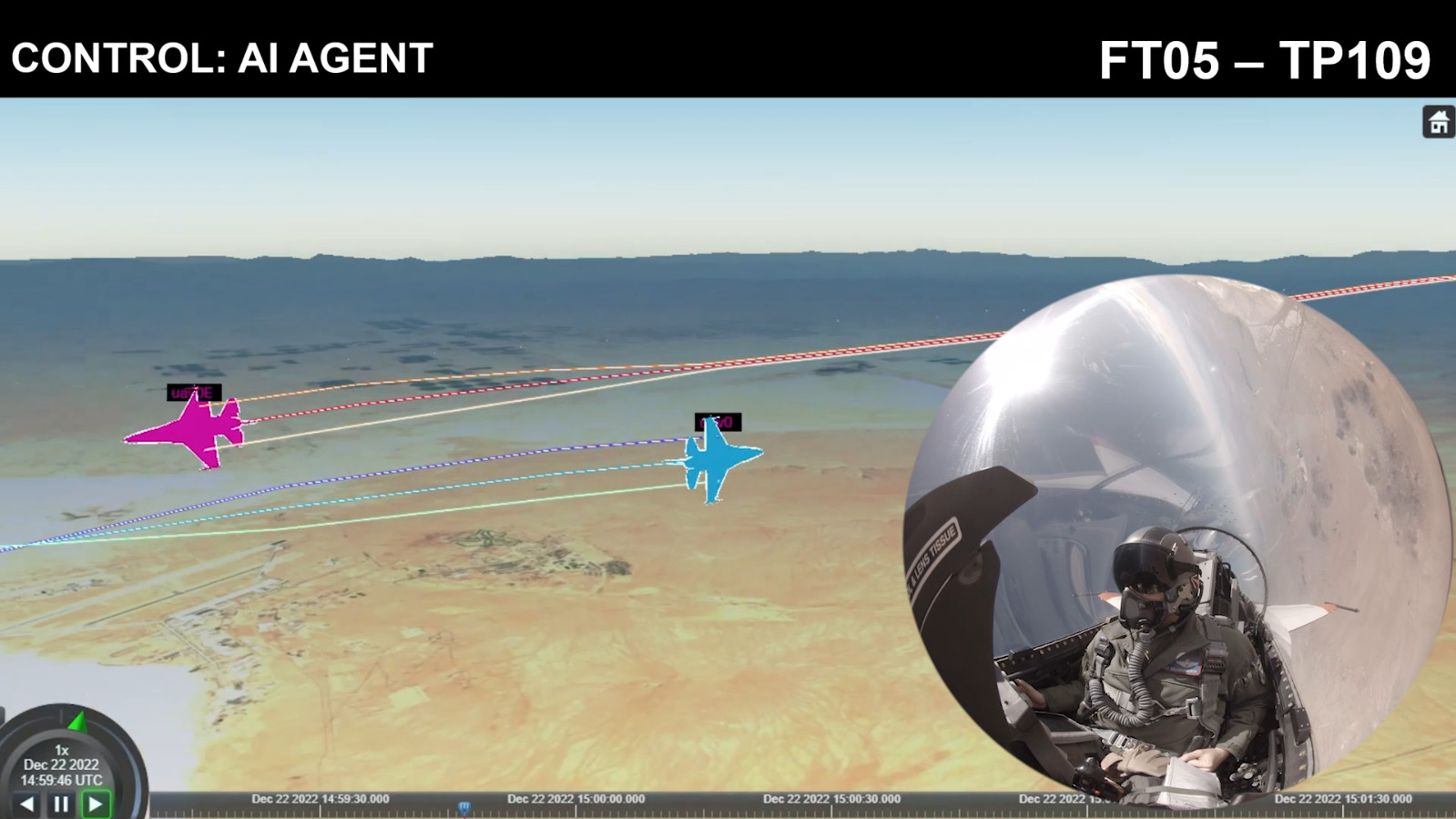
Additional testing using the X-62A in support of ACE has continued into this year and is still ongoing.
The X-62A’s safely conducting dogfighting maneuvers autonomously in relation to another crewed aircraft is a major milestone not just for ACE, but for autonomous flight in general. However, DARPA and the Air Force stress that while dogfighting was the centerpiece of this testing, what ACE is aiming for really goes beyond that specific context.
“It’s very easy to look at the X-62/ACE program and see it as ‘under autonomous control, it can dogfight.’ That misses the point,” Bill “Evil” Gray, the USAF TPS’ chief test pilot, says in the newly released video. “Dogfighting was the problem to solve so we could start testing autonomous artificial intelligence systems in the air. …every lesson we’re learning applies to every task you can give to an autonomous system.”
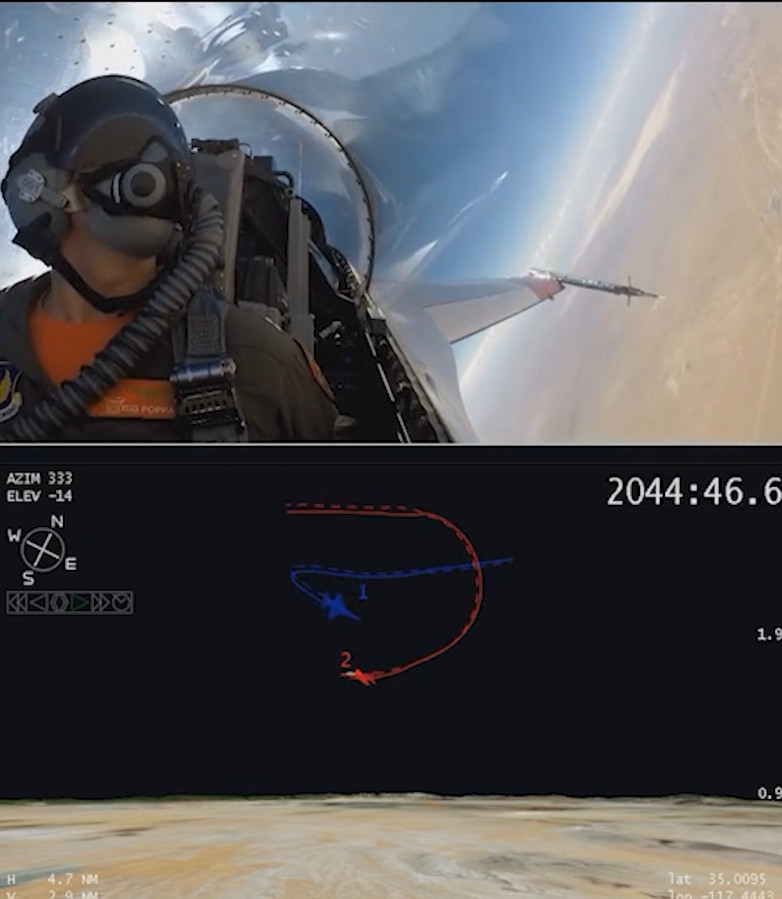
Gray’s comments are in line with what Brandon Tseng, Shield AI’s co-founder, president, and chief growth officer, told The War Zone in an interview earlier this month:
“I tell people that self-driving technology for aircraft enables mission execution, with no remote pilot, no communications, and no GPS. It enables the concept of teaming or swarming where these aircraft can execute the commander’s intent. They can execute a mission, working together dynamically, reading and reacting to each other, to the battlefield, to the adversarial threats, and to civilians on the ground.”
…
“The other value proposition I think of is the system – the fleet of aircraft always gets better. You always have the best AI pilot on an aircraft at any given time. We win 99.9% of engagements with our fighter jet AI pilot, and that’s the worst that it will ever be, which is superhuman. So when you talk about fleet learning, that will be on every single aircraft, you will always have the best quadcopter pilot, you’ll always have the best V-BAT pilot, you’ll always have the best CCA pilot, you name it. It’ll be dominant. You don’t want the second best AI pilot or the third best, because it truly matters that you’re winning these engagements at incredibly high rates.”
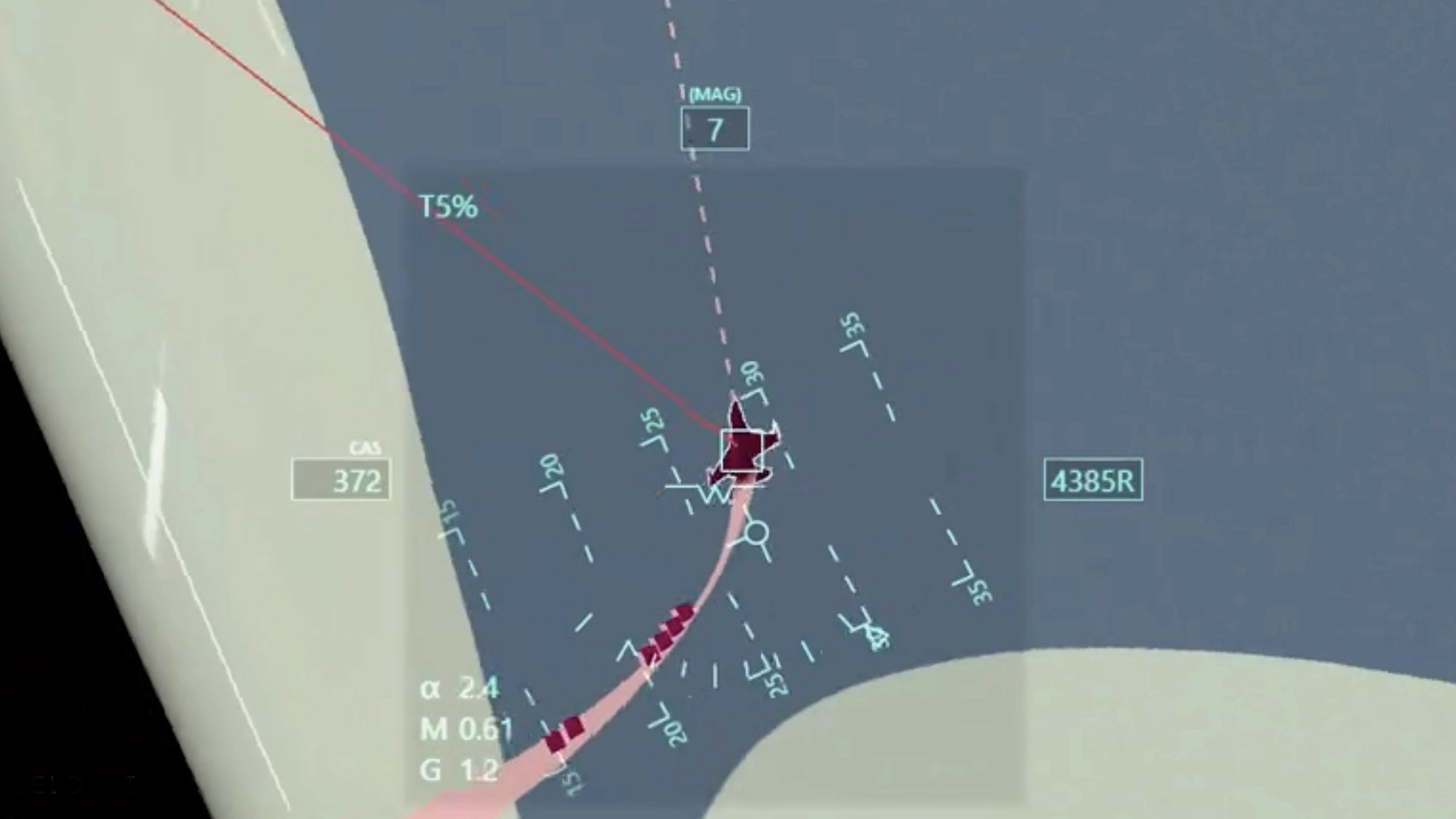
There are still challenges. The new ACE video provides two very helpful definitions of autonomy capability in aerospace development right at the beginning to help in understanding the complexity of the work being done through the program.
The first is so-called rules-based autonomy, which “is very powerful under the right conditions. You write out rules in an ‘if-then’ kind of a way, and these rules have to be robust,” Dr. Daniela Rus from the Massachusetts Institute of Technology’s (MIT) Computer Science & Artificial Intelligence Laboratory (CSAIL), one of ACE’s academic partners, explains at one point. “You need a group of experts who can generate the code to make the system work.”
Historically, when people discuss autonomy in relation to military and civilian aerospace programs, as well as other applications, this has been the kind of autonomy they are talking about.
“The machine learning approach relies on analyzing historical data to make informed decisions for both present and future situations, often discovering insights that are imperceptible to humans or challenging to express through conventional rule-based languages,” Dr. Rus adds. “Machine learning is extraordinarily powerful in environments and situations where conditions fluctuate dynamically making it difficult to establish clear and robust rules.”
Enabling a pilot-optional aircraft like the X-62A to dogfight against a real human opponent who is making unknowable independent decisions is exactly the “environments and situations” being referred to here. Mock engagements like this can be very dangerous even for the most highly trained pilots given their unpredictability.
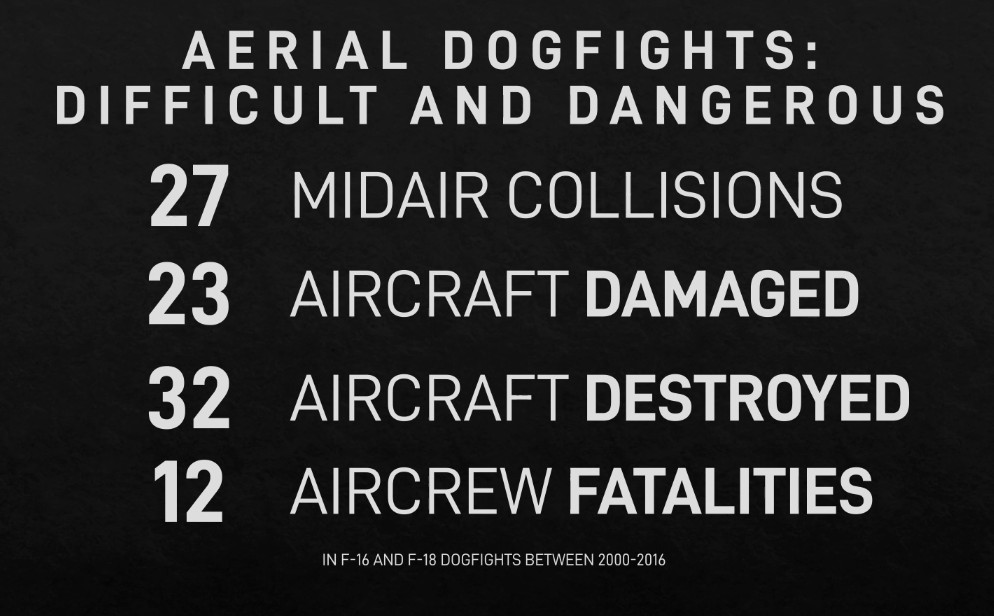
“The flip side of that coin is the challenge” of many elements involved when using artificial intelligence machine learning being “not fully understandable,” Air Force Col. James Valpiani, the USAF TPS commandant, says in the new ACE video.
“Understandability and verification are holding us back from exploring that space,” he adds. “There is not currently a civil or military pathway to certify machine learning agents for flight critical systems.”
According to DARPA and the Air Force, this is really where ACE and the real-world X-62A test flights come into play. One of the major elements of the AI/machine learning “agents” on the VISTA jet is a set of “safety trips” that are designed to prevent the aircraft from performing both dangerous and unethical actions. This includes code to define allowable flight envelopes and to help avoid collisions, either in midair or with the ground, as well as do things like prevent weapons use in authorized scenarios.
The U.S. military insists that a human will always be somewhere in the loop in the operation of future autonomous weapon systems, but where exactly they are in that loop is expected to evolve over time and has already been the subject of much debate. Just earlier this month, The War Zone explored these and other related issues in depth in a feature you can find here.
“We have to be able to trust these algorithms to use them in a real-world setting,” the ACE program manager says.

“While the X-62’s unique safety features have been instrumental in allowing us to take elevated technical risks with these machine learning agents, in this test campaign, there were no violations of the training rules, which codify the airman safety and ethical norms, demonstrating the potential that machine learning has for future aerospace applications,” another speaker, who is not readily identifiable, adds toward the end of the newly released video.
Trust in the ACE algorithms is set to be put to a significant test later this year when Secretary of the Air Force Frank Kendall gets into the cockpit for a test flight.
“I’m going to take a ride in an autonomously flown F-16 later this year,” Kendall said at a hearing before members of the Senate Appropriations Committee last week. “There will be a pilot with me who will just be watching, as I will be, as the autonomous technology works, and hopefully, neither he nor I will be needed to fly the airplane.”
Kendall has previously named ACE as one of several tangential efforts feeding directly into his service’s Collaborative Combat Aircraft (CCA) drone program. The CCA program is seeking to acquire hundreds, if not thousands of lower-cost drones with high degrees of autonomy. These uncrewed aircraft will operate very closely with crewed types, including a new stealthy sixth-generation combat jet being developed under the Next Generation Air Dominance (NGAD) initiative, primarily in the air-to-air role, at least initially. You can read more about the Air Force’s CCA effort here. The U.S. Navy also has a separate CCA program, which is closely intertwined with that of the Air Force and significant new details about which were recently disclosed.
It is important to note that the X-62A is not the only aircraft the Air Force has been using to support advanced autonomy developments in recent years outside of the ACE program. The service is now in the process of transforming six more F-16s into test jets to support larger-scale collaborative autonomy testing as part of another program called Project VENOM (Viper Experimentation and Next-Gen Operations Mode).
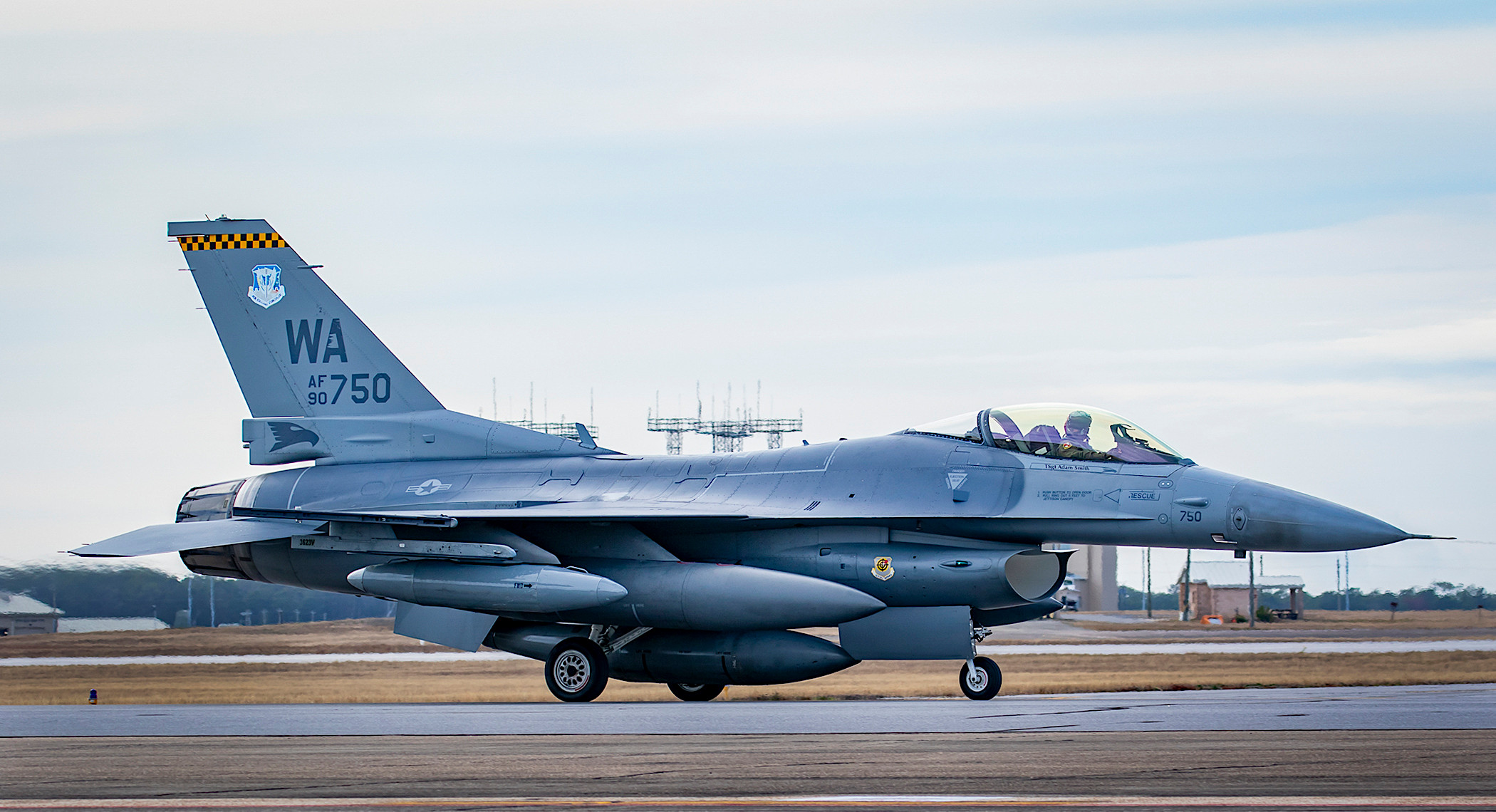
In addition, as already noted, the underlying technology being developed under ACE could have very broad applications. There is great interest across the U.S. military in new AI and machine learning-enabled autonomous capabilities in general. Potential adversaries and global competitors, especially China, are also actively pursuing developments in this field. In particular, the Chinese People’s Liberation Army (PLA) is reportedly working on projects with similar, if not identical aims to ACE and the AlphaDogfight Trials. This could all have impacts on the commercial aviation sector, as well.
“What the X-62/CE team has done is really a paradigm shift,” USAF commandant Valpiani says at the end of the newly released video. “We’ve fundamentally changed the conversation by showing this can be done safely and responsibly, and so now we’ve created a pathway for others to follow in building machine learning applications for air and space.”
More details about the use of the X-62A in support of ACE are already set to be revealed later this week and it will be exciting to learn more about what the program has achieved.
Contact the author: joe@twz.com
